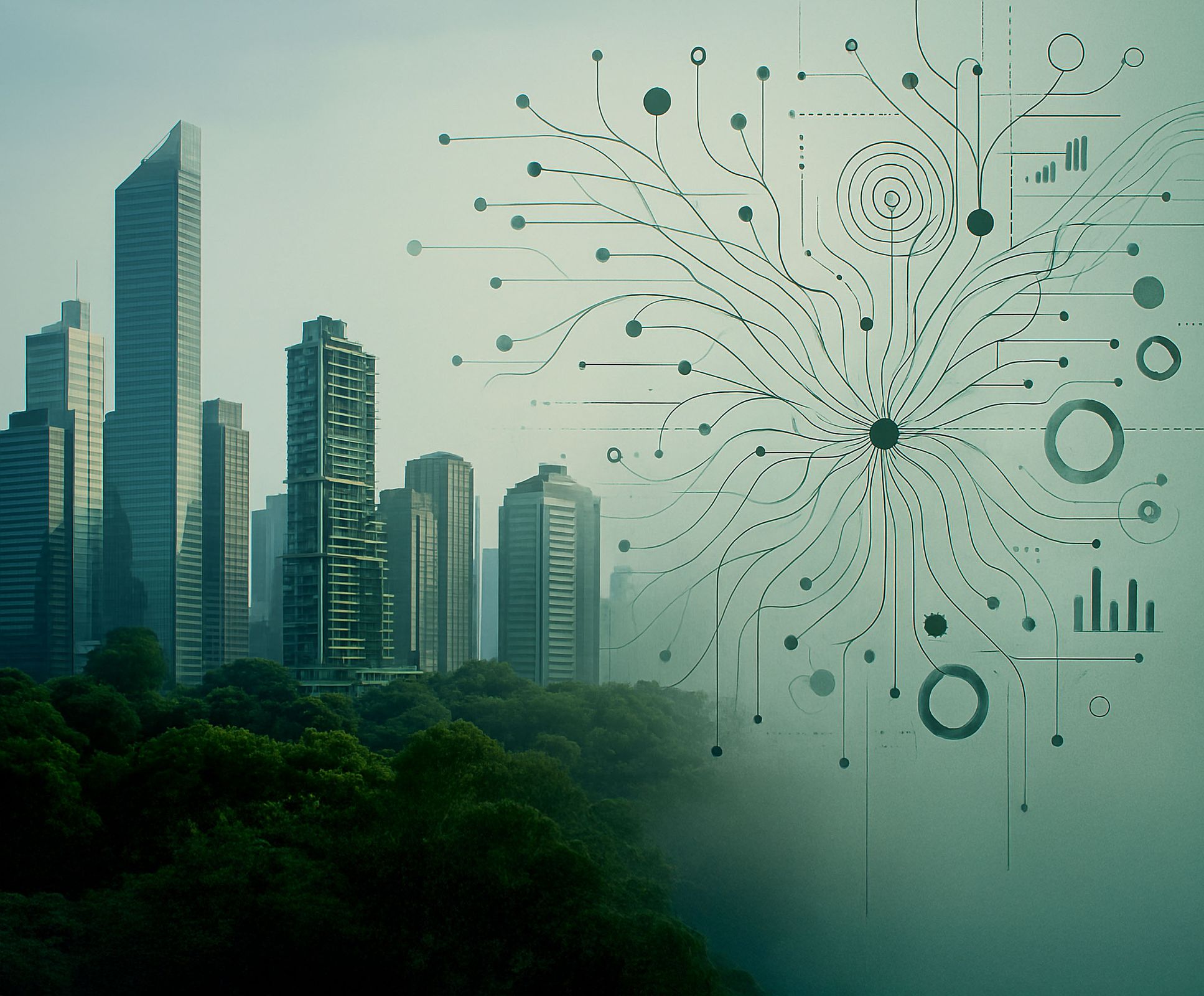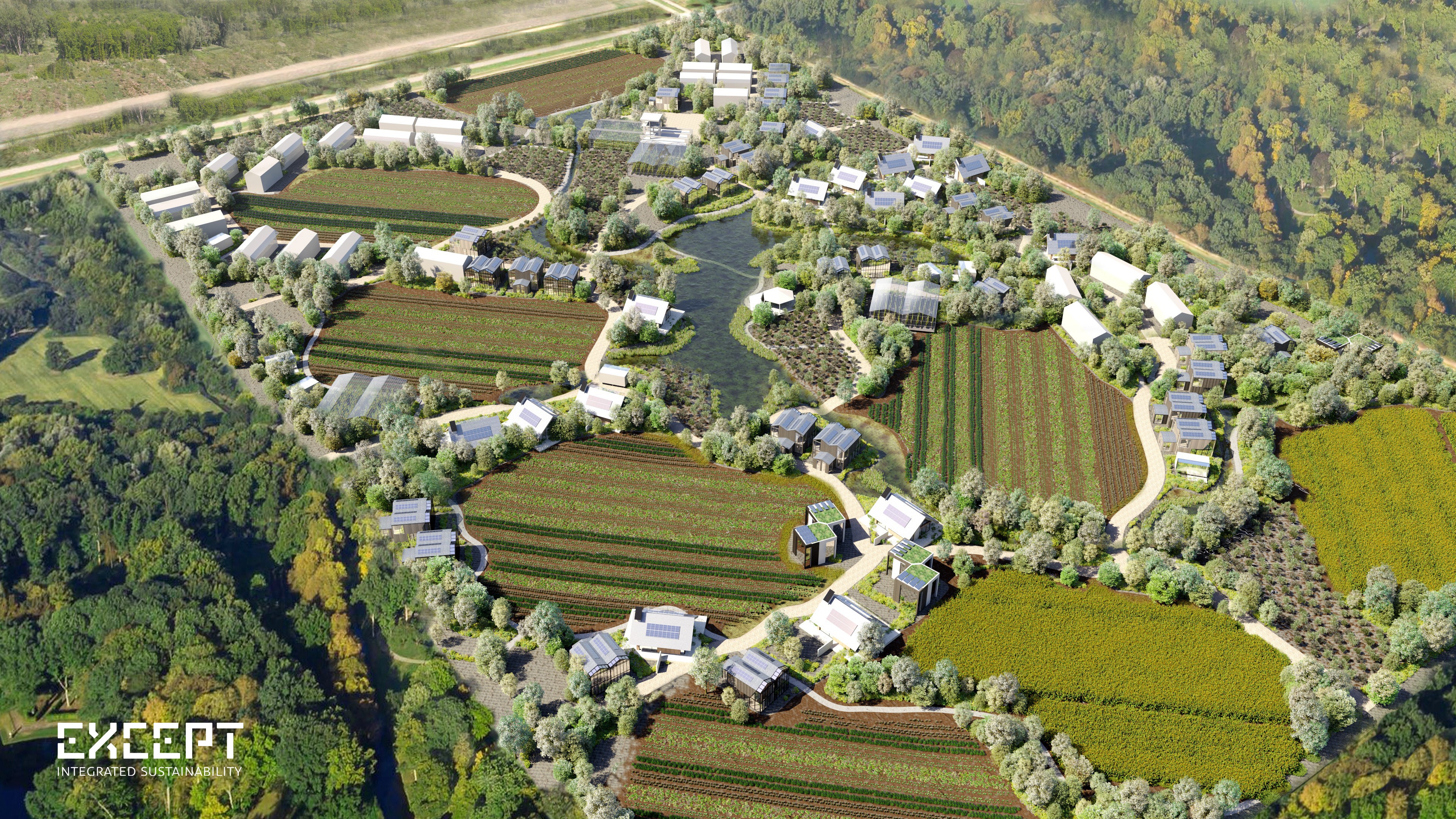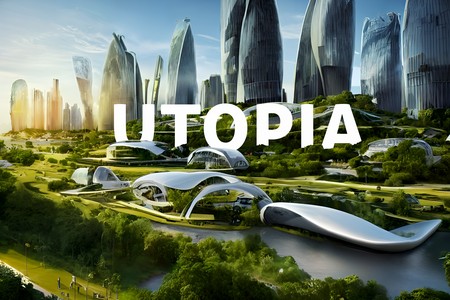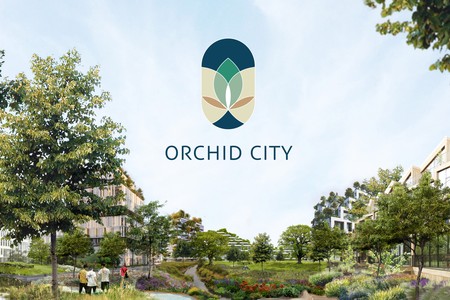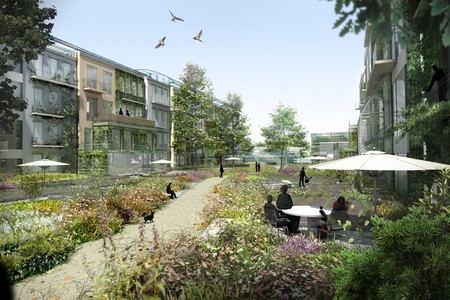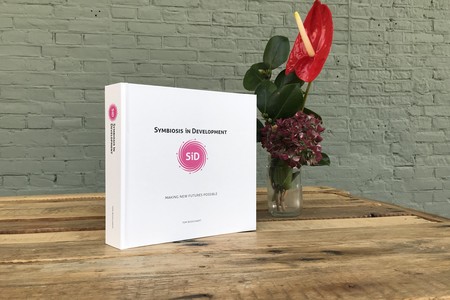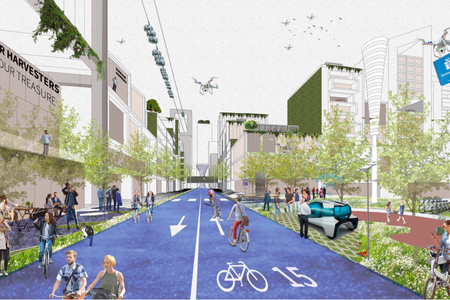Cities aren’t just where we live; they’re the engines of our future—and they need a radical reboot. Moving beyond the usual “less harm” approach, regenerative cities aim to restore ecosystems, fuel economic prosperity, and build strong social bonds. In the process, they transform how we plan, build, and govern our urban environments—so we can all thrive for generations to come.
Come with us on this latest long-read to see what regenerative cities are, and how we can practically work to realize them, relying on the SiD framework for systemic sustainable development.
Why Do We Need Regenerative Cities?
Cities are at the heart of global challenges and solutions. They consume nearly 80% of global energy, emit over 70% of CO2 emissions, and house the majority of the world’s population. Rapid urbanization means cities will keep growing, despite resource depletion, and climate change putting immense pressure on our built environments and the economics that govern them.
While sustainability has long been a goal for many cities, it often focuses on minimizing harm rather than creating a net-positive impact and economic prosperity, both equally important for thriving cities. Regenerative cities go beyond a basic understanding of sustainability, by actively restoring ecosystems, enhancing community well-being, and fostering economic resilience. They do not merely reduce negative impacts—they contribute positively to their environments, making them healthier, more equitable, and more adaptive to future challenges.
How to build Regenerative cities? In this article we discuss the main approaches based on our 25 years of working on regenerative and sustainable cities, industries, and organizations.
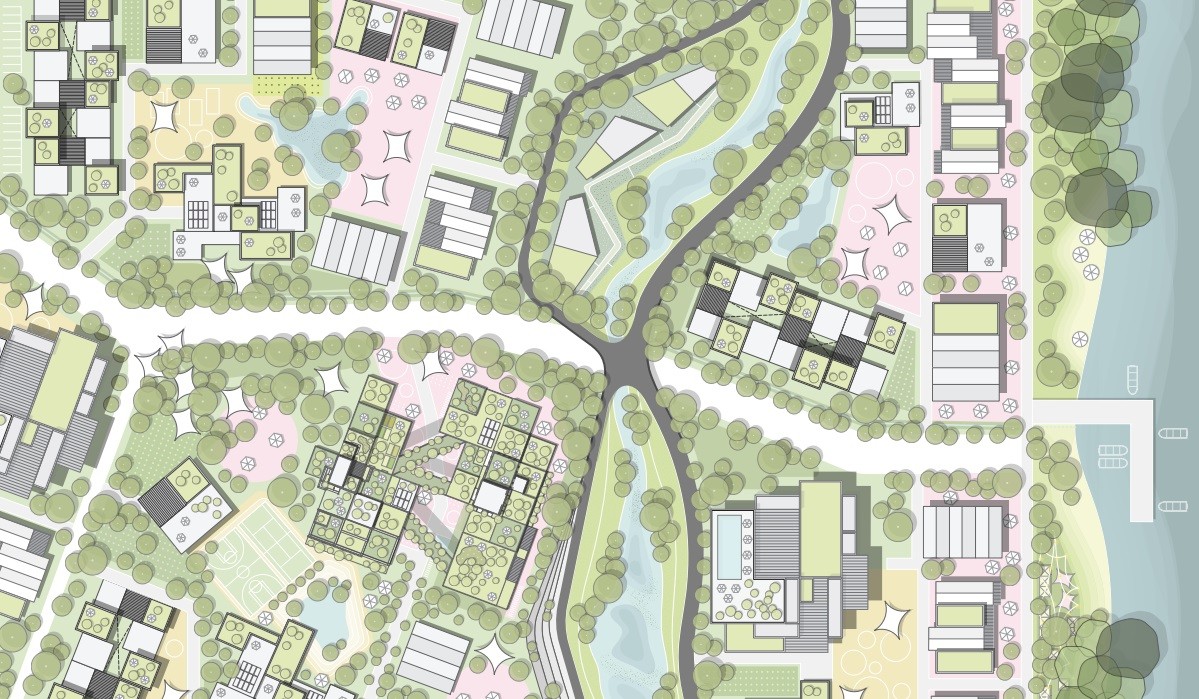
The Limitations of Current Urban Sustainability Approaches
Traditional sustainability approaches in urban planning often operate within short-term policy cycles, emphasizing incremental improvements in energy efficiency, waste reduction, or transportation. While these efforts are necessary, they fail to address the systemic and long term nature of urban challenges. Current methods tend to focus on isolated solutions, such as renewable energy deployment, the “15 minute city” or green buildings, without integrating the broader social, ecological, and economic systems in which they operate. This fragmented approach results in missed opportunities for long-term resilience and self-sufficiency.
A New Paradigm: Regenerative Cities
Regenerative cities embrace a systemic approach, recognizing that cities function as living organisms with interconnected layers. This is in itself not new, and also covers approaches that have been around or decades, building in the work of many in this field, and learning from a wealth of successful (and less successful) projects. Read about our research into them here, in Learning from Failed Utopia.
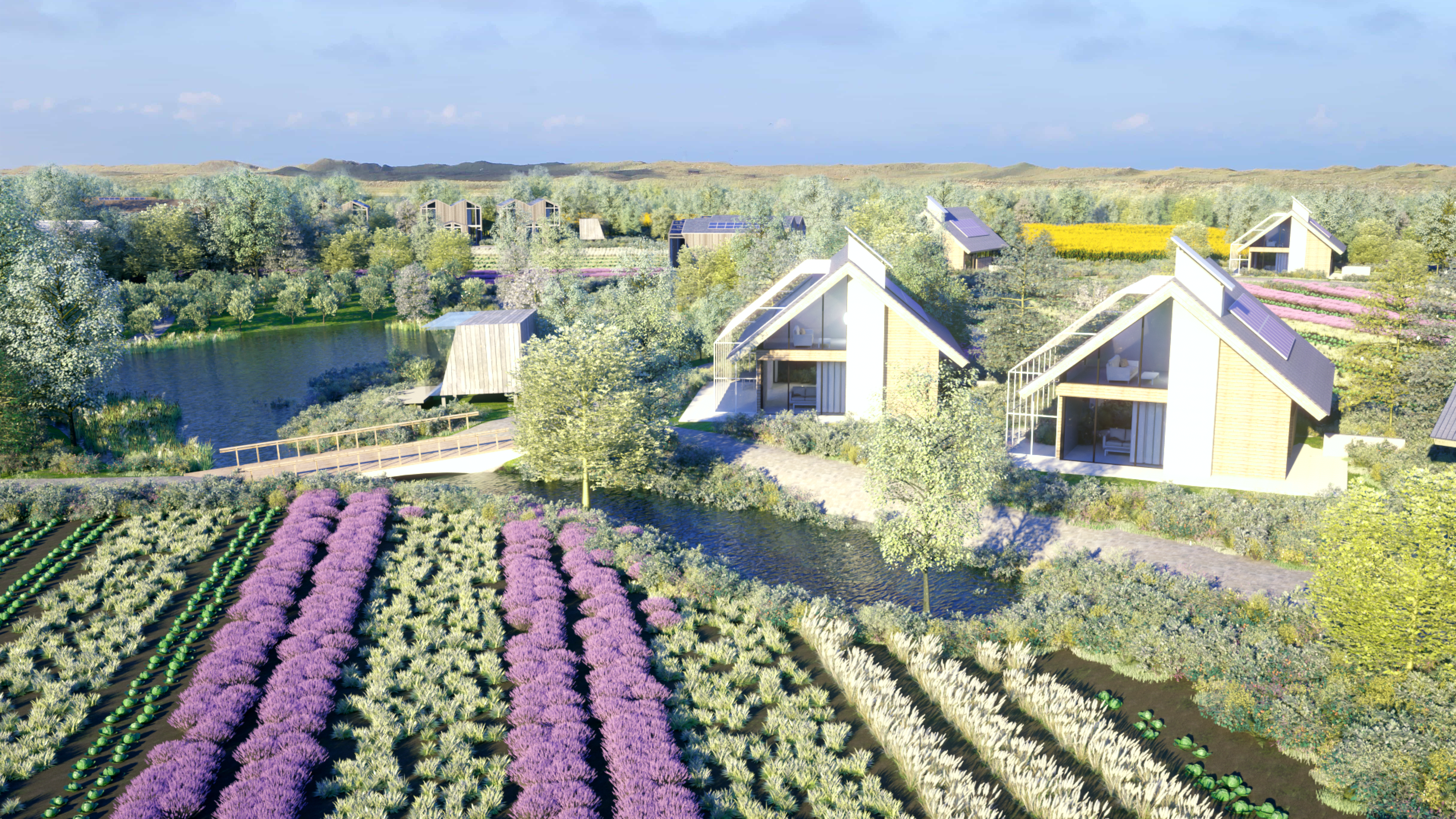
What will we be looking at?
Inspired by Symbiosis in Development (SiD), a framework that integrates systems thinking, design thinking, cocreation and agile work methods to build cities that restore rather than exploit their environments, we explore the essential components of what is a regenerative city, and how to realize the transformation of our urban centers into that direction. By implementing a circular economy, regenerative ecosystem management, and community-driven governance models, cities can become net-positive contributors to climate, economy, and society.
After our recent in-depth research article 'Learning from Failed Utopia', this longread look at the notion of regenerative cities, their transformative potential, and the methodologies needed to bring them to life.
Below, we break down the principles of regeneration using the SiD framework, illustrate real-world applications, and provide an action plan for city officials, developers, planners, and citizens to initiate systemic urban transformation., and provide an action plan for city officials, developers, planners, and citizens to initiate systemic urban transformation.
By rethinking the way we design, build, and govern our cities, we can create environments that thrive within planetary boundaries while enhancing quality of life for all.
An example of the outcome of applying SiD to cities is the Orchid City regenerative city model. Developed with SiD over the course of several years with experts from around the globe, Orchid City enables the rapid development of regenerative neighborhood and city plans, both newly developed and to adapt existing areas.
This enables a true climate-adaptive, affordable, profitable and carbon positive living place, with a whopping 140% reduction in carbon footprint, that have lower living costs than average neighborhoods. In their full form, they provide all essential living needs, in a lush, healthy and diverse environment, combined with meaningful work and circular industry as a powerful economic engine.
Read more about Orchid City here. We’ll use some examples of Orchid City throughout this article.
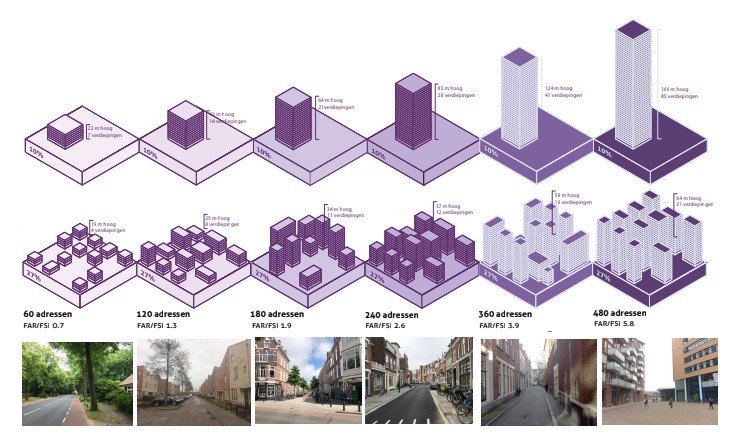
2. What is a Regenerative City?
Defining Regenerative Cities
A regenerative city is an urban environment that actively enhances and replenishes the ecological, social, and economic systems it depends on. Unlike sustainable cities that aim to reduce harm, regenerative cities create positive environmental and social impacts, ensuring long-term resilience, self-sufficiency, and well-being for all inhabitants.
SiD shows us that, on a systems level (the level of the whole of the city - and its ‘regional shadow’-), a city that can survive and thrive indefinitely into the future needs to have three properties:
- Autonomy; have access to sufficient essential resources (water, energy, waste processing, jobs, building materials, etc)
- Resilience; the ability to recover from and adapt to unexpected events and changes in context
- Harmony; a population that has no need to seek conflict within itself
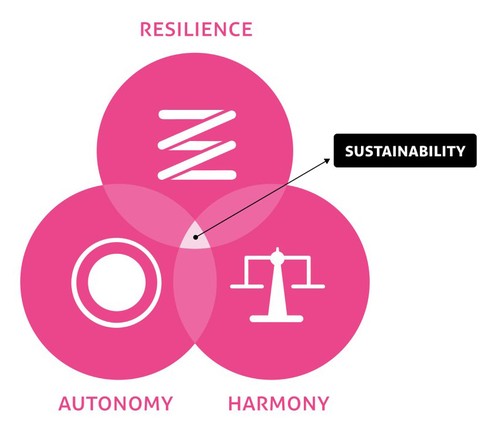
All other properties that a sustainable city needs fall within the domain of one of these three. For example, climate adaptation falls under resilience, circularity and good availability falls under autonomy, and equitable resource distribution under harmony.
No city on earth is currently in that sustainable state. We are actively ‘consuming’ our future, and cities are on a ticking clock to adapt towards a future where we can survive, and thrive. Our cities are also far from resilient, and entrenched infrastructural notions make inhabitants greatly dependent on overly large and costly transport systems, that in turn have a large footprint.
The Circularity Gap Report tracks the circularity (part of Autonomy) of the global economy. In the most recent report from 2024 it is shown that global circularity is still in decline. “The share of secondary materials consumed by the global economy has decreased from 9.1% in 2018 to 7.2% in 2023—a 21% drop over the course of five years. “, and consumption accelerates. “In the same period, we have consumed over 500 gigatonnes. That's 28% of all the materials humanity has consumed since 1900.”.
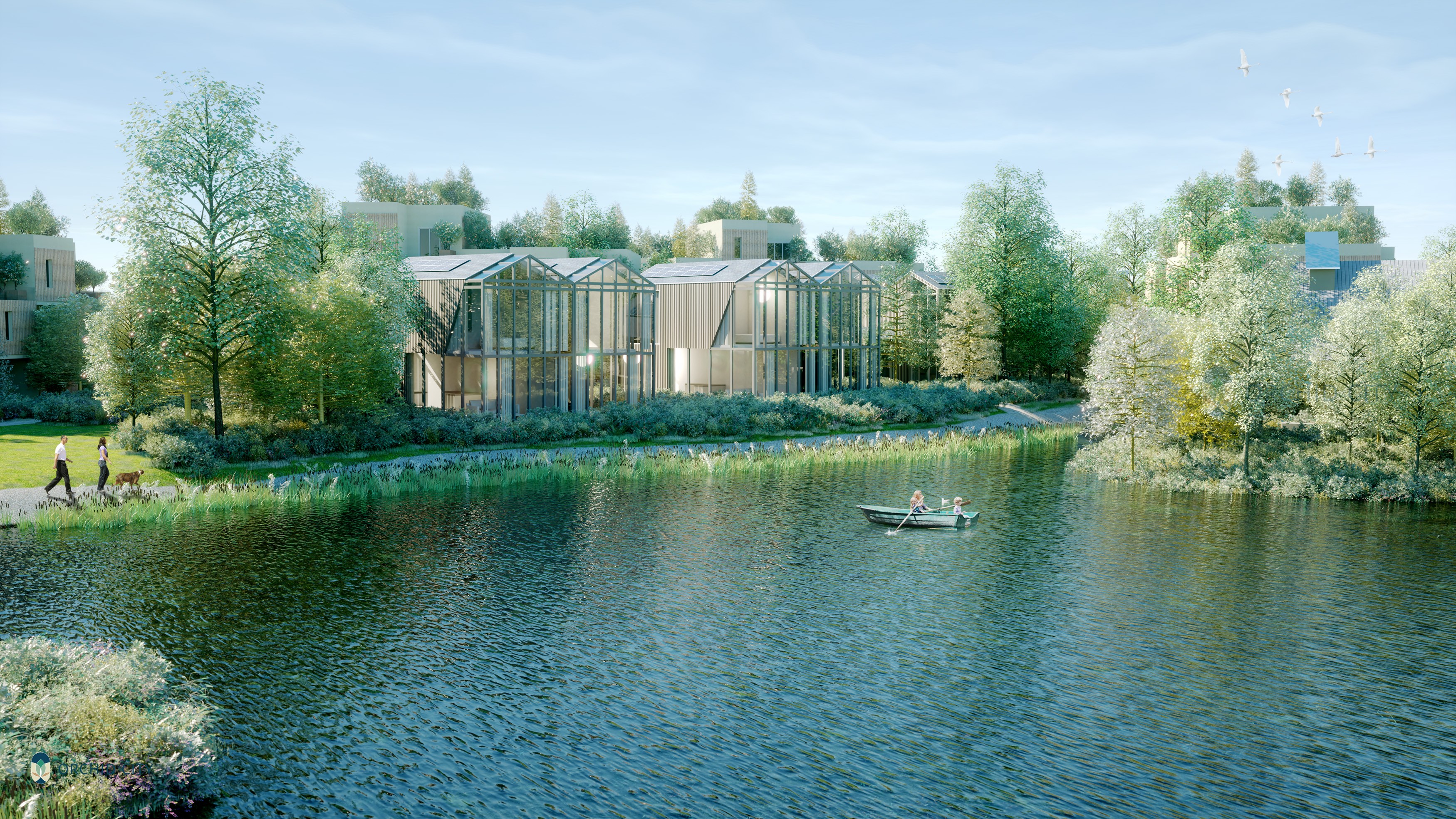
A regenerative city is a city that is actively transforming towards a sustainable state, and is recovering from its damaging state. Regeneration is not just about mitigating negative impacts—it is about reversing damage, restoring natural cycles, and fostering dynamic, adaptive urban ecosystems.
Regenerative cities are designed to integrate with nature, support strong social structures, and create economic systems that function within planetary boundaries. As with most large transitions, this is far easier to achieve in cities that are new to build than transforming existing, entrenched urban areas, but it can be done for both.
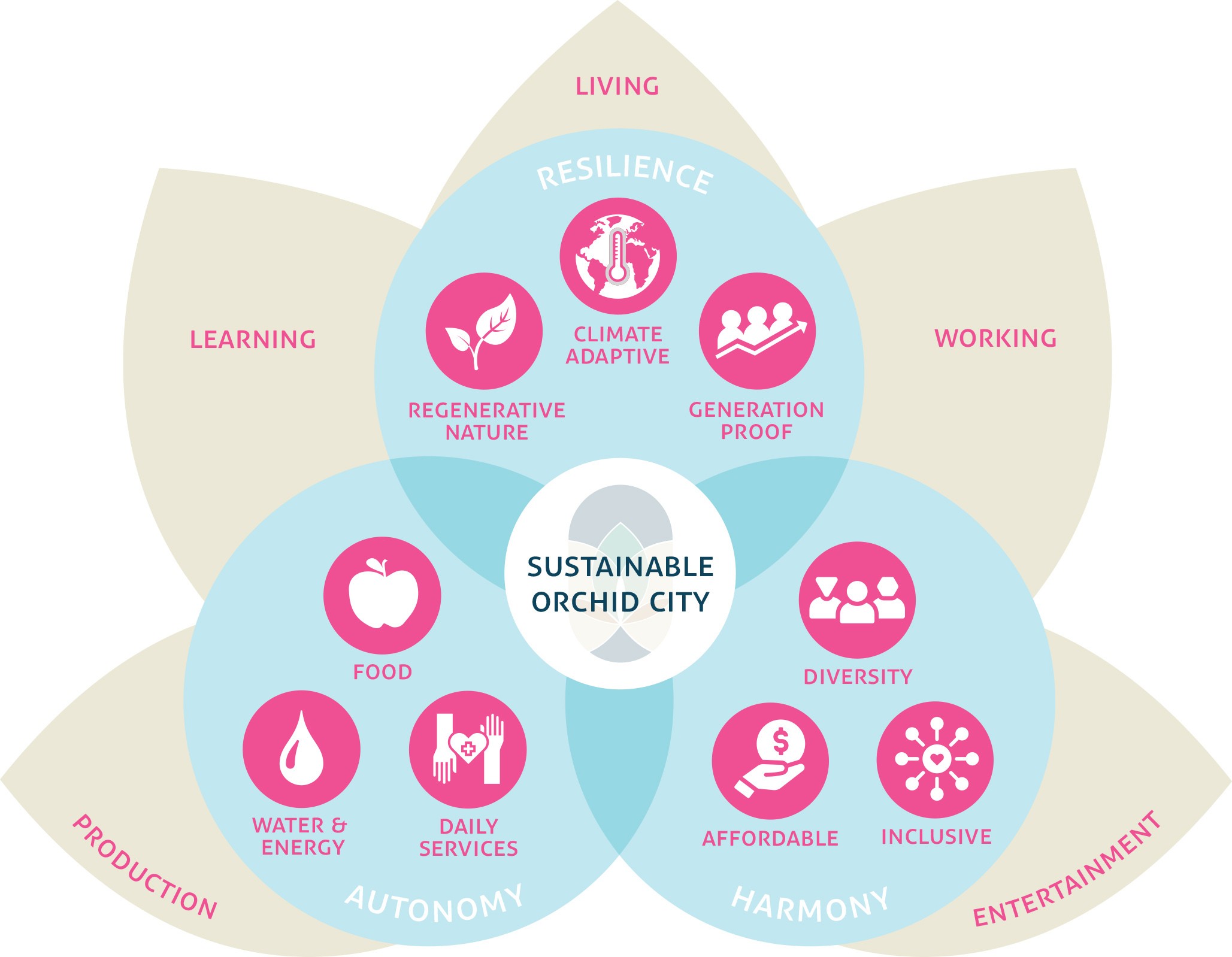
Key Principles of Regenerative Cities
To fully realize the potential of regenerative cities, they must be designed and governed based on the following core principles:
- Autonomy and Self-Sufficiency – Regenerative cities must produce more clean energy, water, and food than they consume. This requires adopting circular economy principles, localized energy grids, water capture and reuse systems, and urban agriculture to ensure self-sufficiency in essential resources. Regenerative cities should focus on local production capabilities in energy, food, and materials to reduce reliance on external supply chains. This also enhances economic stability and reduces environmental footprints.
- Resilience to Change – Cities must be designed to withstand environmental, social, and economic shocks. This includes climate adaptation measures, diversified economic structures, and community-based governance models that enhance systemic resilience. Utilizing the SiD resilience toolkit, cities can measure and enhance their stability against future uncertainties.
- Harmonious Urban Environments – Equity and social well-being are fundamental to regenerative cities. Ensuring access to resources, fostering community engagement, and promoting inclusivity help build cohesive, thriving societies. This also involves designing urban spaces that prioritize human health, public safety, and cultural richness.
- Integrated Ecosystem Management – Cities should work with, rather than against, nature. This involves protecting and restoring biodiversity, integrating ecosystem services into urban design (such as wetlands for water filtration), and employing regenerative land-use practices to enhance natural resilience.
- Adaptive Governance and Long-Term Vision – Regenerative cities require governance models that support long-term planning and adaptability. Moving beyond short-term political cycles, city officials must establish transformation roadmaps that prioritize systemic change over decades, ensuring continuous progress towards regenerative goals.
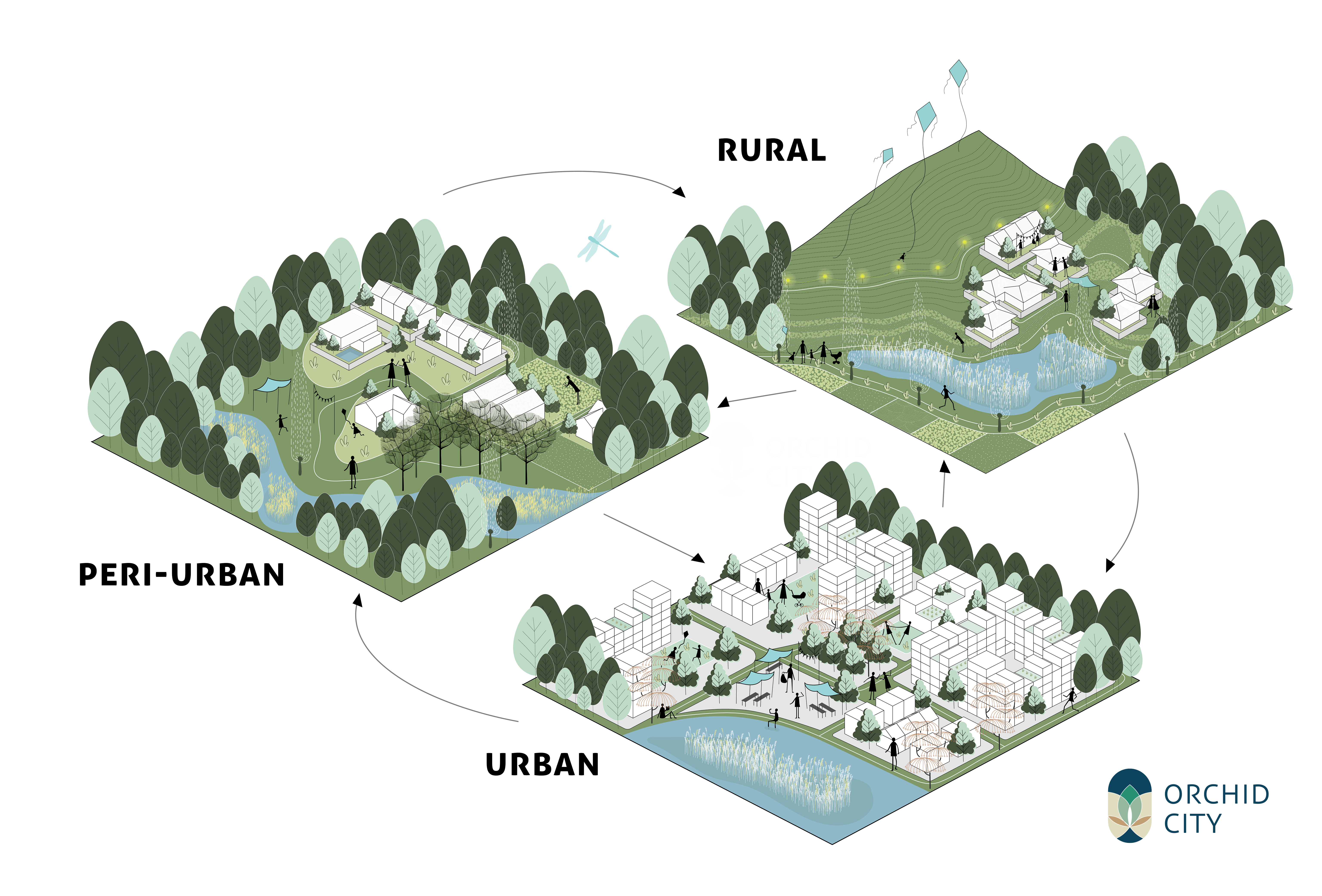
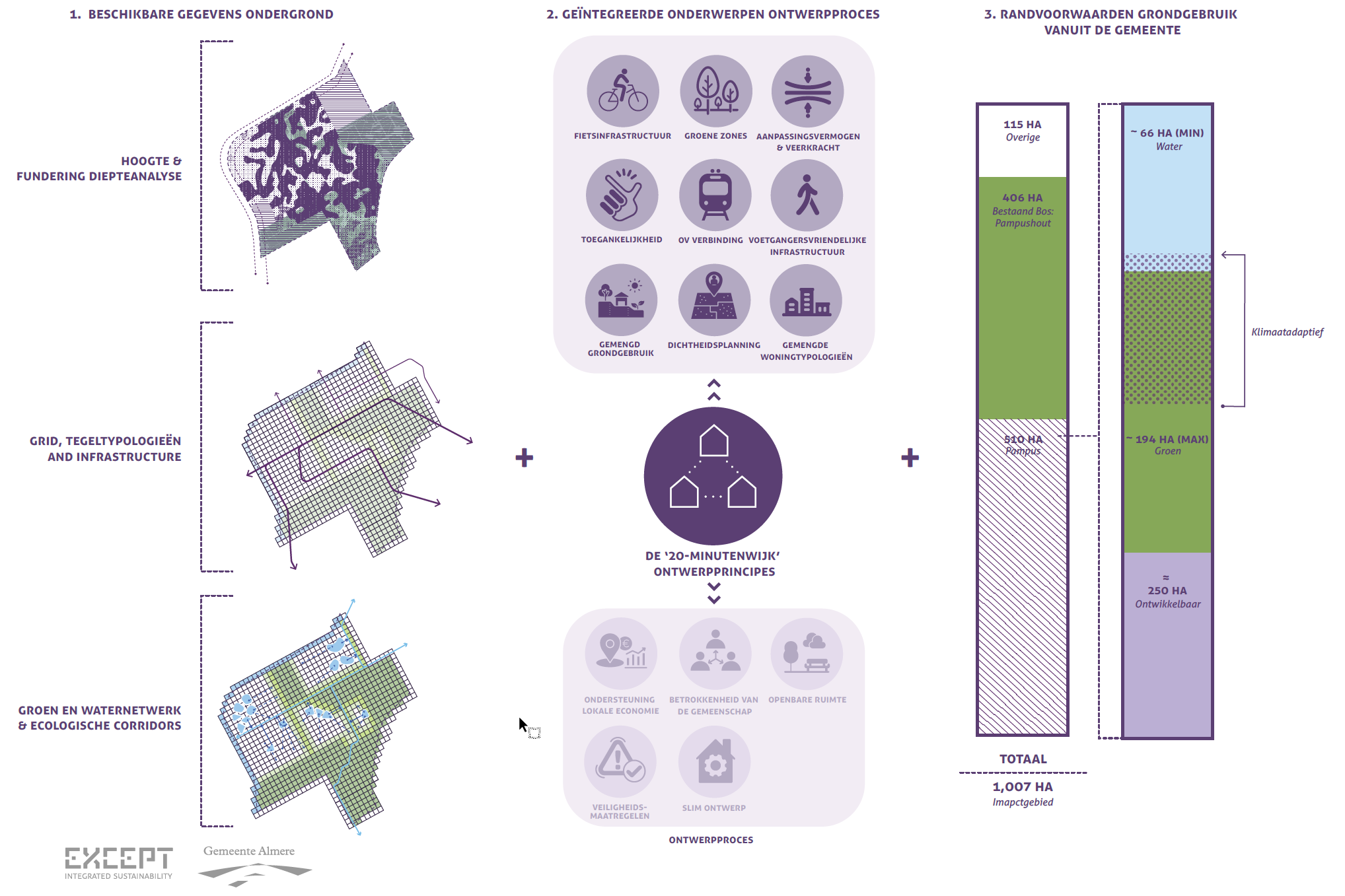
By integrating regenerative design principles, leveraging systemic urban planning frameworks like SiD, and engaging communities in participatory decision-making, cities can evolve into ecosystems that generate net-positive outcomes for both people and nature. This requires collaboration across multiple sectors, investment in long-term infrastructure, and a commitment to holistic, systems-based thinking.
The next section explores how the Symbiosis in Development (SiD) framework provides a structured methodology for planning and implementing regenerative urban systems.
3. Using Symbiosis in Development (SiD) for Regenerative Cities
A Holistic Approach to Urban Regeneration
The Symbiosis in Development (SiD) framework is a comprehensive methodology designed to facilitate the transition towards regenerative systems, such as cities, organizations and industry. Unlike traditional planning models that focus on isolated sustainability measures, SiD adopts a systemic, interdisciplinary approach that integrates ecological restoration, social equity, and economic viability into a unified strategy. SiD is an open source framework, documentation and learning resources are freely available via www.thinksid.org.
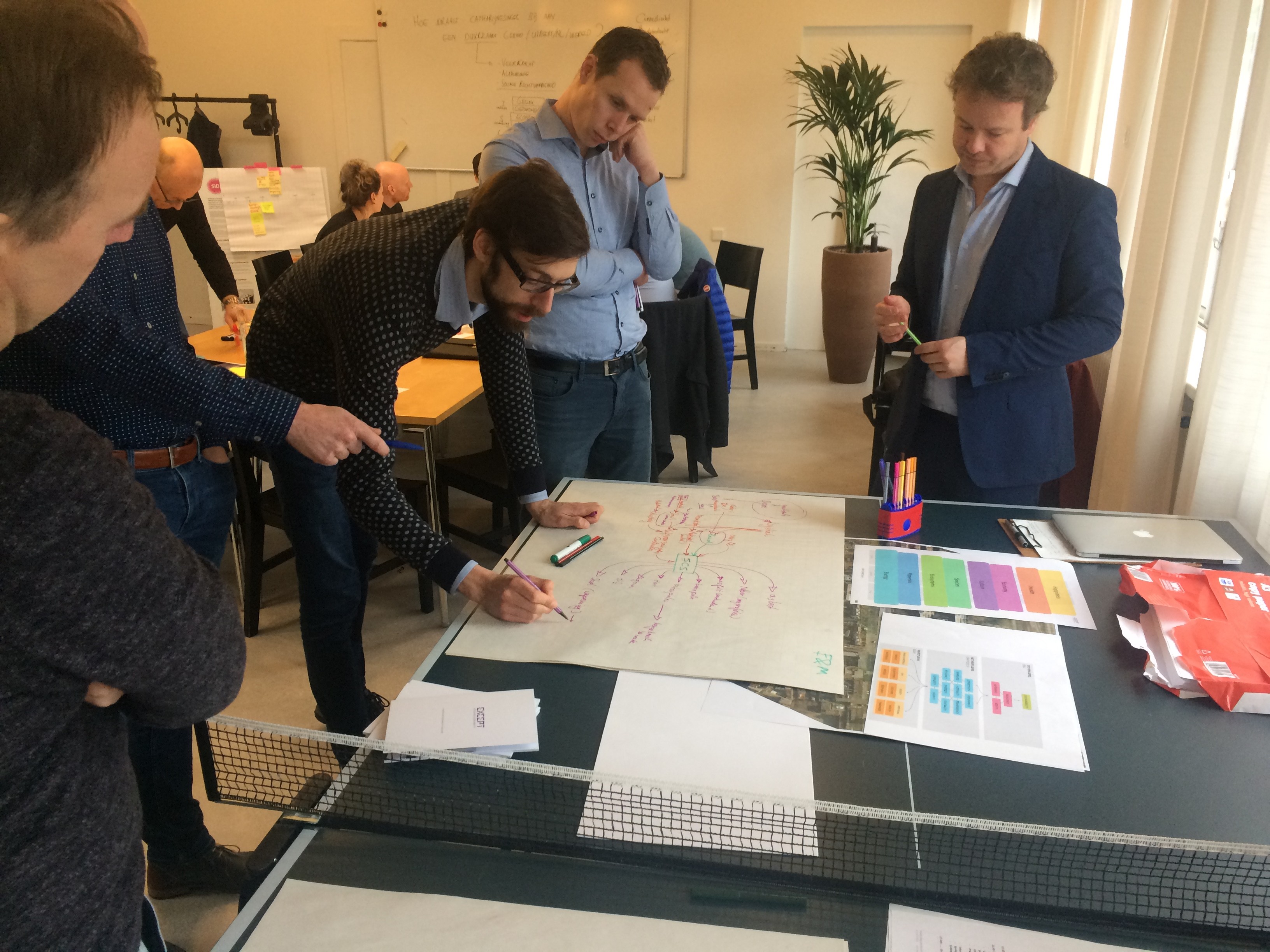
The Three Core Layers of SiD
SiD structures urban transformation into three interconnected layers: the System Layer, the Network Layer, and the Physical Layer. Each of these layers plays a critical role in ensuring cities operate as resilient, autonomous, and harmonious entities.
- System Layer – This layer provides the overarching vision and strategic direction for urban regeneration. It defines the key objectives, such as resilience to environmental disruptions, energy independence, and inclusive governance. The System Layer ensures that regenerative goals align with long-term policy frameworks and global sustainability targets.
- Network Layer – The Network Layer focuses on the relationships and interactions between different sectors, institutions, and stakeholders. This includes governance structures, economic flows, social systems, and technological innovations. A regenerative city requires strong collaboration between public authorities, private enterprises, and community organizations to foster innovation and shared responsibility in urban development. SiD has a comprehensive set of network-layer indicators available to aid rapid analysis.
- Physical Layer – The Physical Layer addresses the tangible aspects of the urban environment, including infrastructure, architecture, green spaces, energy systems, and waste management. By integrating nature-based solutions, circular economy principles, and smart city technologies, the Physical Layer ensures that cities regenerate rather than deplete their resources. The physical layer is further subdivided using the ELSI categorization tool below.
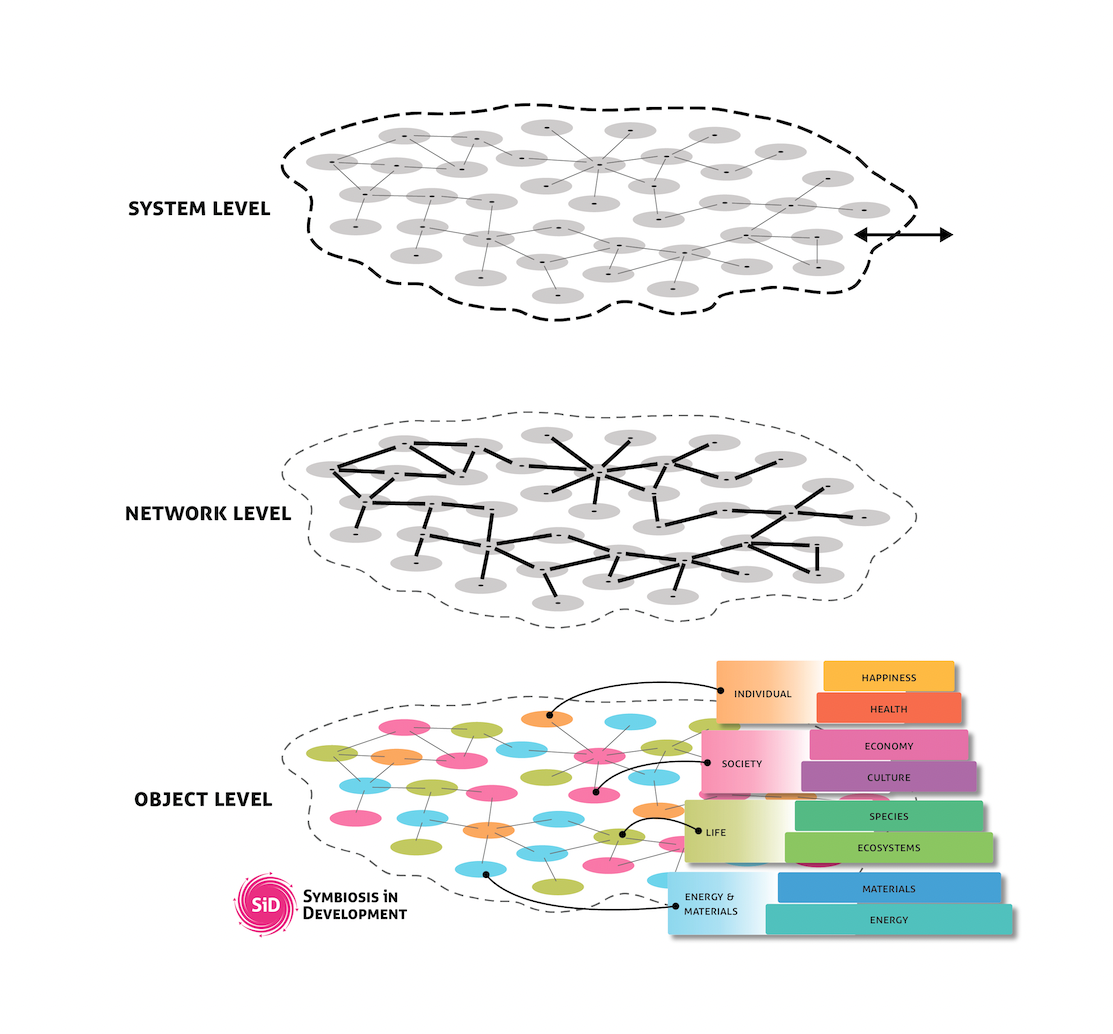
The ELSI Framework: Integrating Sustainability into Urban Design
To guide the practical implementation of regenerative city principles, SiD employs the ELSI framework to unravel the physical layer, which categorizes key urban components into four fundamental domains:
- Energy & Materials – Developing cities that operate on renewable energy sources, resource-efficient building materials, and closed-loop manufacturing systems.
- Life & Ecosystems – Enhancing urban biodiversity, restoring natural habitats, and integrating ecosystem services into city planning.
- Society & Culture – Promoting participatory governance, social equity, and inclusive urban policies that empower local communities.
- Individuals & Well-being – Ensuring access to quality healthcare, education, affordable housing, and public services that support human flourishing.
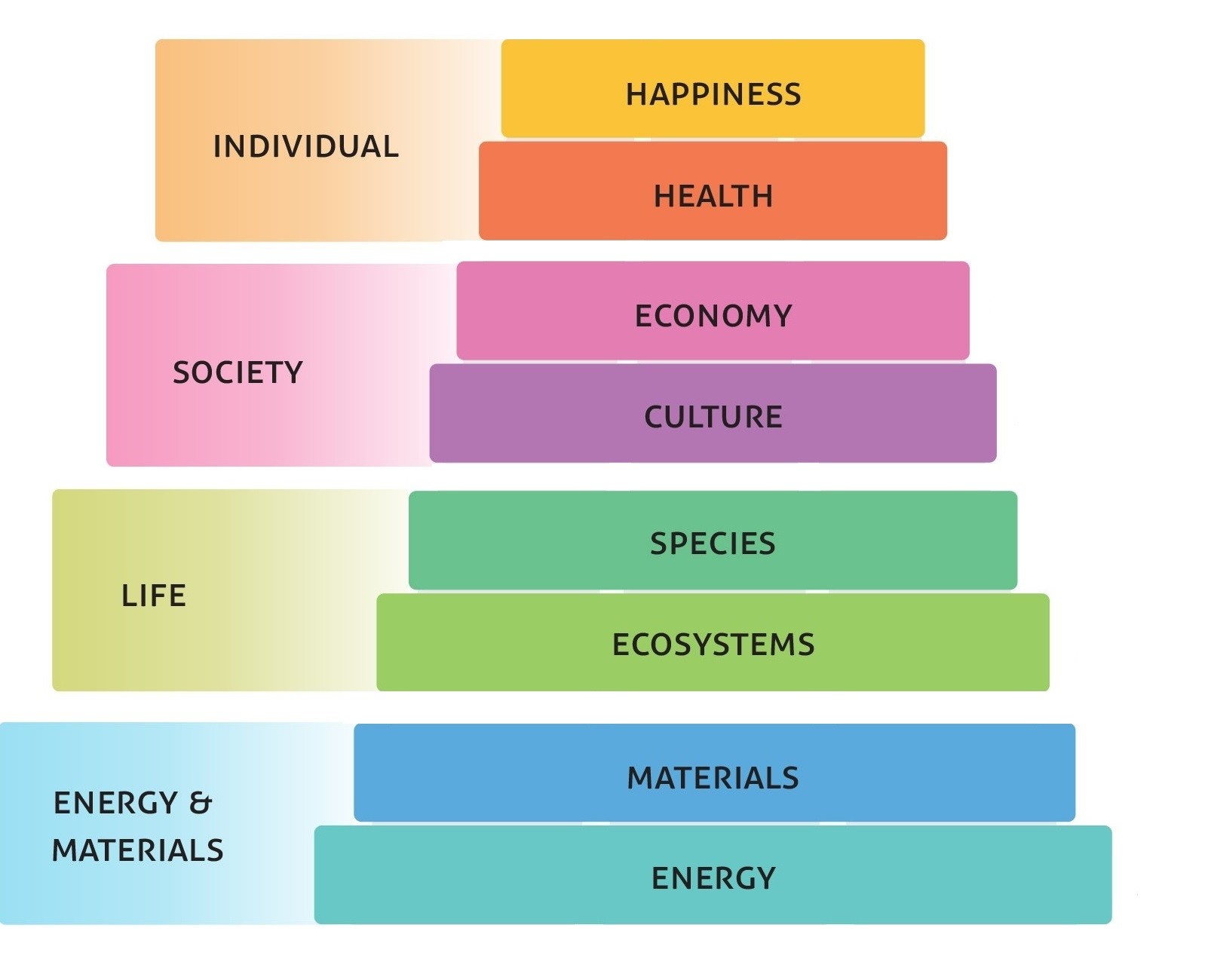
For example, for the Orchid City regenerative city model, all four of these domains are addressed in both a physical, social, and economic sense to integrate innovations that help strengthen the whole.
See the urban metabolism map below, which shows how Orchid City is able to be fully resource self-sufficient, while also boosting biodiversity, climate adaptation, and a healthy and safe natural environment.
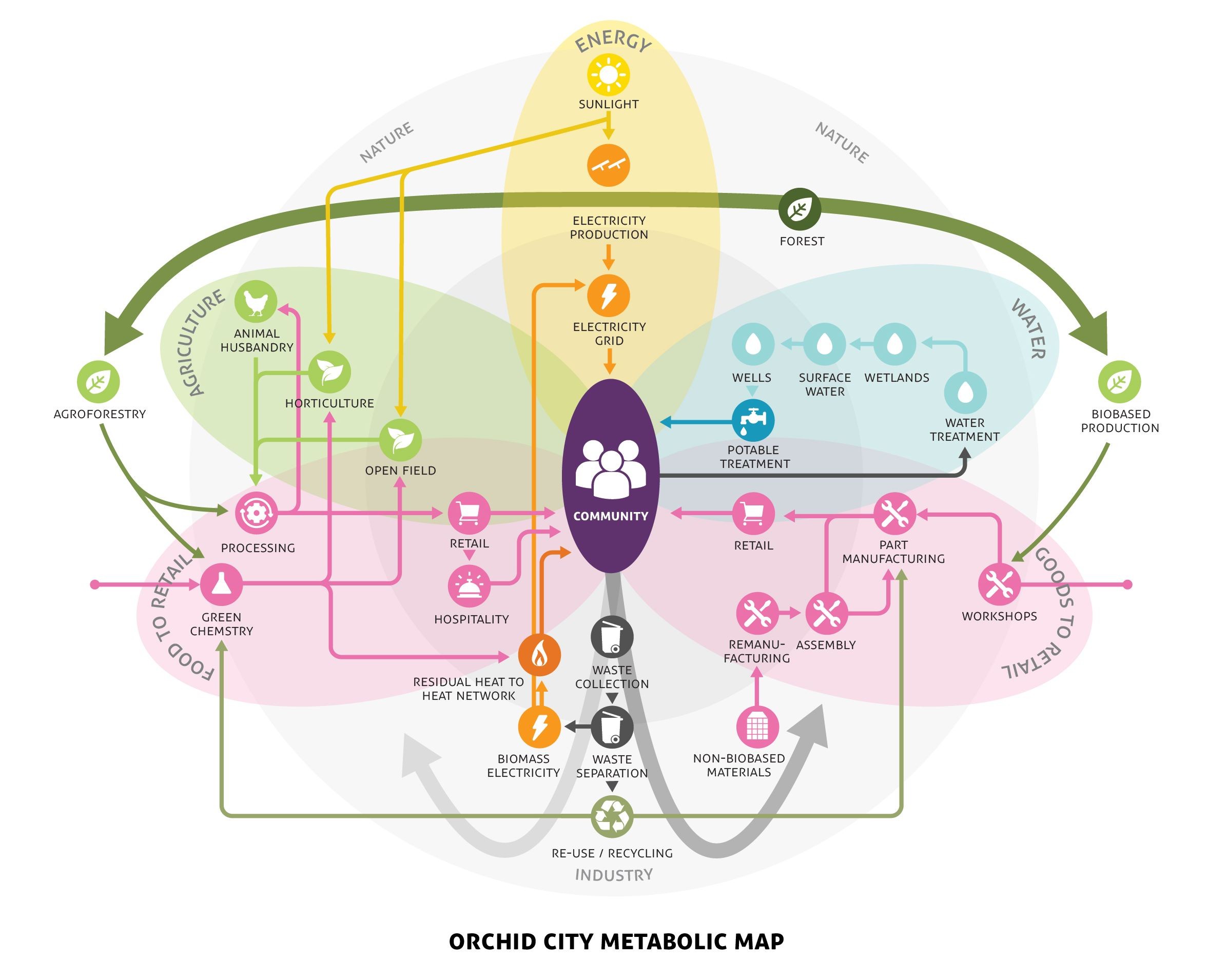
SiD Development principles for regenerative cities
To practically develop regenerative cities, the Symbiosis in Development (SiD) framework follows these key principles and approaches:
1. Comprehensive Systems Analysis
- Employ visual system maps to gain a full understanding of urban metabolism, biodiversity and bioregional strategies, transport flows, and programmatic planning.
- These maps reveal hidden interdependencies and highlight resources, processes, and areas of potential intervention.
2. Multidisciplinary Stakeholder Co‑creation
- Involve a wide range of experts in science, engineering, economics, sociology, politics, and community leadership, alongside major community groups, businesses, and institutions.
- Facilitate hands‑on workshops in iterative cycles that develop and refine integrated scenarios, evaluate feasibility, and assess impacts.
- A dedicated core team of facilitators and subject‑matter experts supports the workshops with data, materials, and guidance. The resulting ideas feed into an evolving roadmap and living set of development plans.
3. Rapid Iteration Cycles
- Avoid creating a single, massive plan that risks becoming slow, resource‑intensive, and prone to failure. Instead, organize short “development sprints.”. The SiD development cycle for regenerative cities breaks up the plan development into 3-4 phases per year, after which yearly ‘improvement’ cycles help to steer the long term development.
- In these sprints, specialized teams focus on specific areas such as agriculture, water, waste management, public transport, or housing. Their work then converges to form an integrated vision.
- This cyclical process allows for continuous improvement and swift adjustment to new information, while ensuring all stakeholders remain informed and suitably involved.
4. Roadmap‑Driven Planning
- Rely on long‑term roadmaps as a core policy and strategy tool, with physical plans and interventions emerging as regular outputs.
- Integrate transition science methods (e.g., DRIFT’s X‑model) to inform policymaking, guide systemic change, and adapt to evolving conditions.
- Ensure that each step in the roadmap builds toward a unified vision, while retaining flexibility for updates and improvements over time.
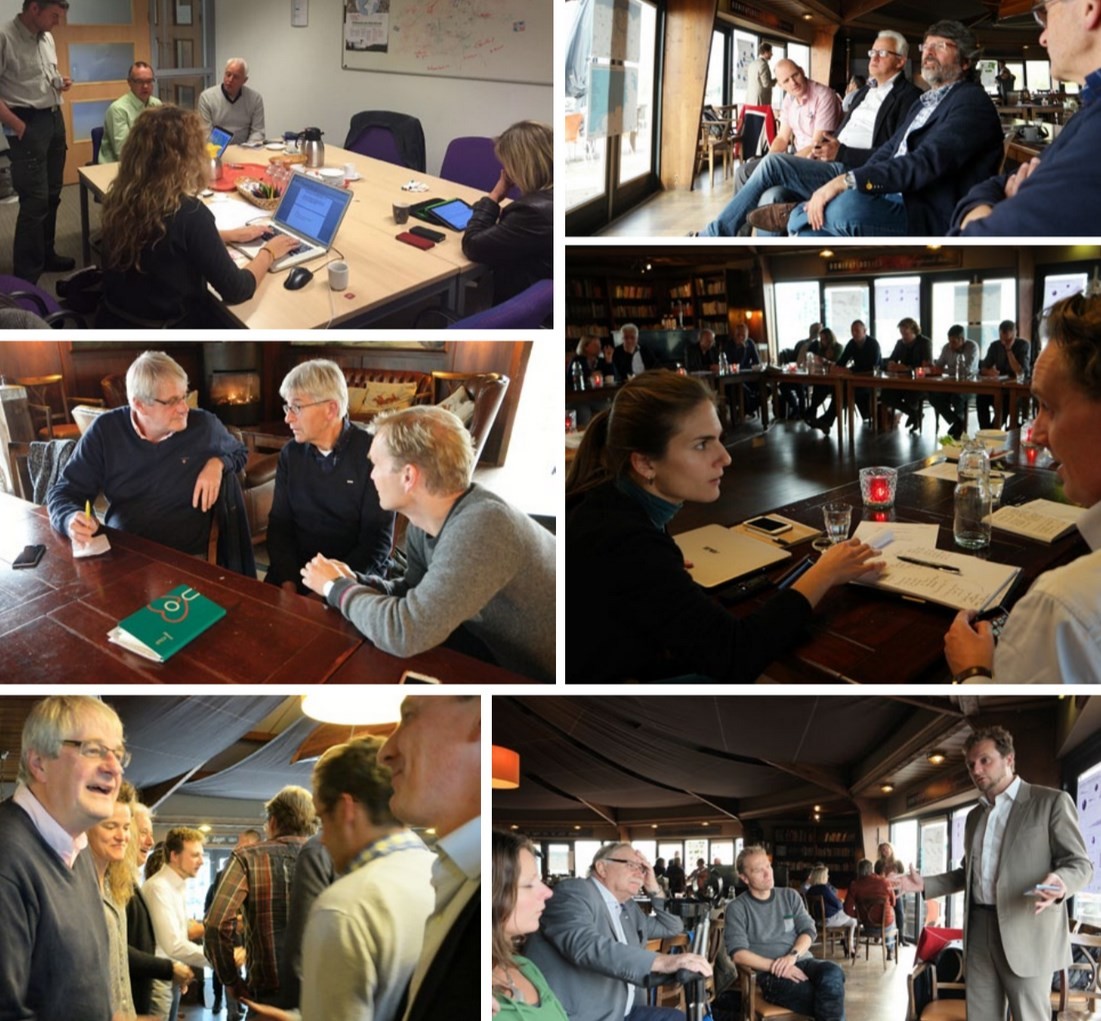
Regenerative city roadmap development steps outlined
The below process outlines a 1 year regenerative city roadmap development trajectory.
Months 1–2: Initiation
In this phase the project is set up, the core working team defined, trajectory planned, and initial stakeholders analyzed and involved.
1. Team Composition & Leadership Setup
- Identify core project coordinators, including a lead facilitator who understands SiD’s approach.
- Assemble a cross‑functional team (e.g., planners, engineers, data scientists, communication leads) and clarify each member’s role and responsibilities.
2. Project Goal Setting & Planning
- Define the overarching objectives and scope for the roadmap (e.g., local/regional boundaries, resource focus, timeline).
- Establish success criteria and key performance indicators (KPIs).
- Outline a high‑level work plan with milestones and deliverables.
- Setup collaboration and data sharing systems for online and offline use by stakeholders
3. Initial Stakeholder Analysis & Involvement Strategy
- Map relevant stakeholder groups: local government, community groups, NGOs, businesses, and academia.
- Determine levels and modes of involvement (e.g., interviews, surveys, workshops).
- Begin initial outreach to key stakeholders to gather expectations and build support.
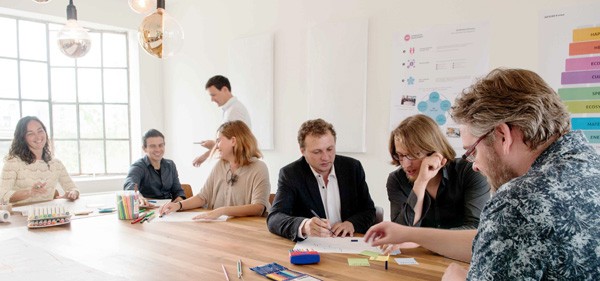
Months 3–4: Intelligence Phase
In this phase all intelligence is collected to inform all participants, get a broad and deep oversight into the current situation, as well as being able to learn from other initiatives to not reinvent the wheel and use the most current and accurate intelligence available in the process.
1. Precedent & Trend Analysis
- Research similar projects and best practices from comparable cities or regions.
- Identify emerging trends in technology, policy, demographics, or finance that could affect the project’s direction.
2. Data Structuring & Collection
- Gather relevant data: demographic, economic, environmental, infrastructural. Use the SiD ELSI system to break down the data collection.
- Collect existing documentation, plans, visions and strategies.
- Classify and store information in the central repository for easy retrieval.
- Begin analyzing data for gaps and further research needs.
3. First Systems Analysis
- Construct preliminary system maps (e.g., energy flows, water cycles, material loops, mobility networks).
- Identify hotspots, bottlenecks, and opportunities.
- Share initial findings with the team and selected stakeholders to validate and refine.
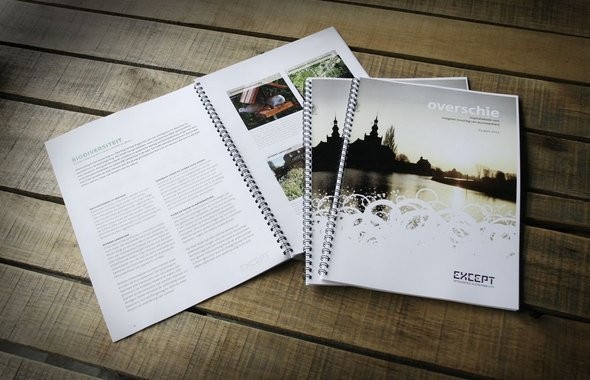
Months 5–7: Co‑Creation & Solutions Phase
In this phase everything comes together. The data and analysis is used during several intense co-creation sessions which last several days in a row, for a close-knit and rapid planning process. During these sessions scenarios are explored and an initial long term roadmap is shaped. In between the sessions, these are analyzed, feasibility and limitations evaluated, to enable decision makers the overview needed to provide steering and support.
1. Co‑Creation Planning
- Develop a detailed schedule for workshops or “solution sprints.”
- Prepare materials (data summaries, interactive system maps, scenario templates).
2. Stakeholder Workshops & Scenario Planning
- Conduct multi‑disciplinary workshops involving experts, community representatives, and policymakers.
- Generate, test, and refine multiple future scenarios (e.g., different policy or infrastructure approaches).
- Use systems thinking tools (e.g., dynamic maps, design charettes) to visualize impacts and trade‑offs.
3. Processing Outputs & Converging on Options
- Synthesize workshop results, identify promising interventions, and outline short‑, medium‑, and long‑term initiatives.
- Evaluate feasibility based on social, economic, and environmental criteria.
- Update the system maps to reflect newly generated ideas and potential solutions.
- Draft working roadmaps as final output and communication tools
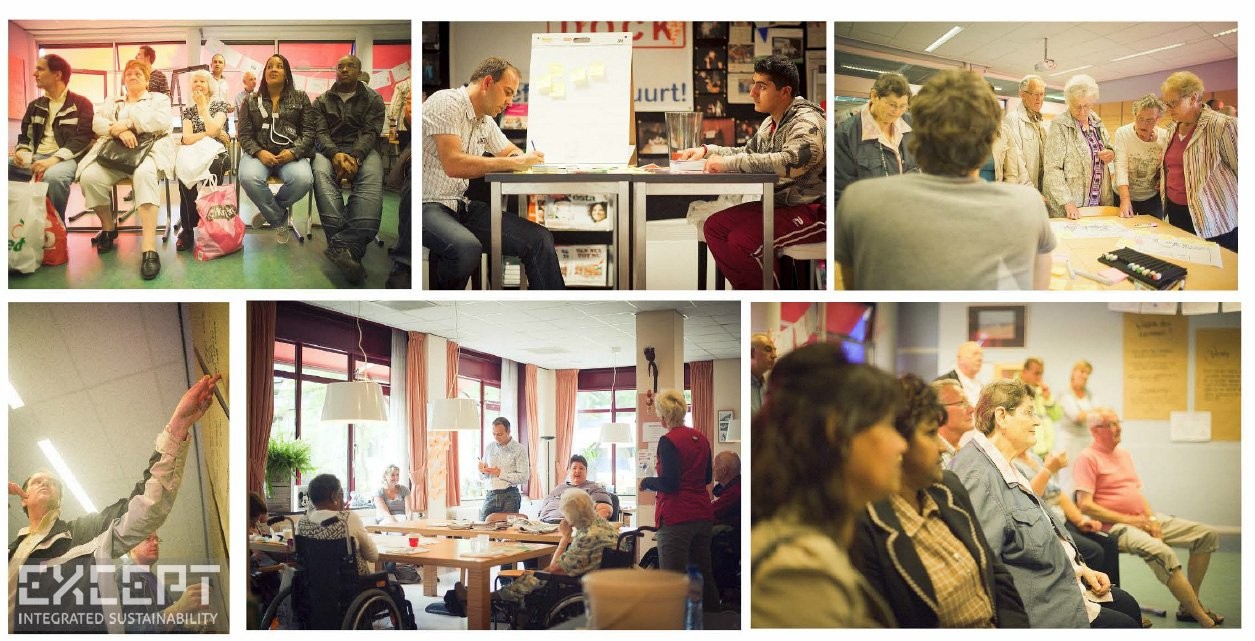
Months 8–12: Roadmap Refinement & Adoption
1. Roadmap Refinement
- Review and refine draft roadmap that integrates all scenario outcomes, solutions, and recommended actions with key stakeholders for each domain.
- Organize the roadmap into clear phases, with timelines, budget estimates, and responsible parties.
2. Scenario Selection & Evaluation
- Present the refined scenarios and roadmap options to public officials, private stakeholders, and community representatives.
- Gather feedback and prioritize interventions based on consensus and strategic impact.
- Incorporate feedback to finalize scenario choices.
3. Feasibility Analysis & Action Planning
- Perform in‑depth technical, financial, and regulatory feasibility studies on the selected interventions.
- Draft implementation plans, detailing roles, responsibilities, and funding options.
- Identify “quick‑win” pilot projects and catalysts to begin in the following months.
4. Communication & Final Roadmap Output
- Publicly share the final roadmap, ensuring clarity on objectives, actions, and benefits.
- Outline next steps for governance, execution management, and ongoing stakeholder engagement.
- Prepare the project handoff to the relevant authorities, ensuring continuous monitoring and adjustments as the roadmap unfolds.
Outcome
By the end of the year, a collaboratively defined, data‑driven roadmap is in place, containing a range of feasible initiatives, prioritized actions, and clear alignment among public and private stakeholders. This first roadmap forms the foundation for continued development, iterative improvement, and the subsequent phases of project execution.
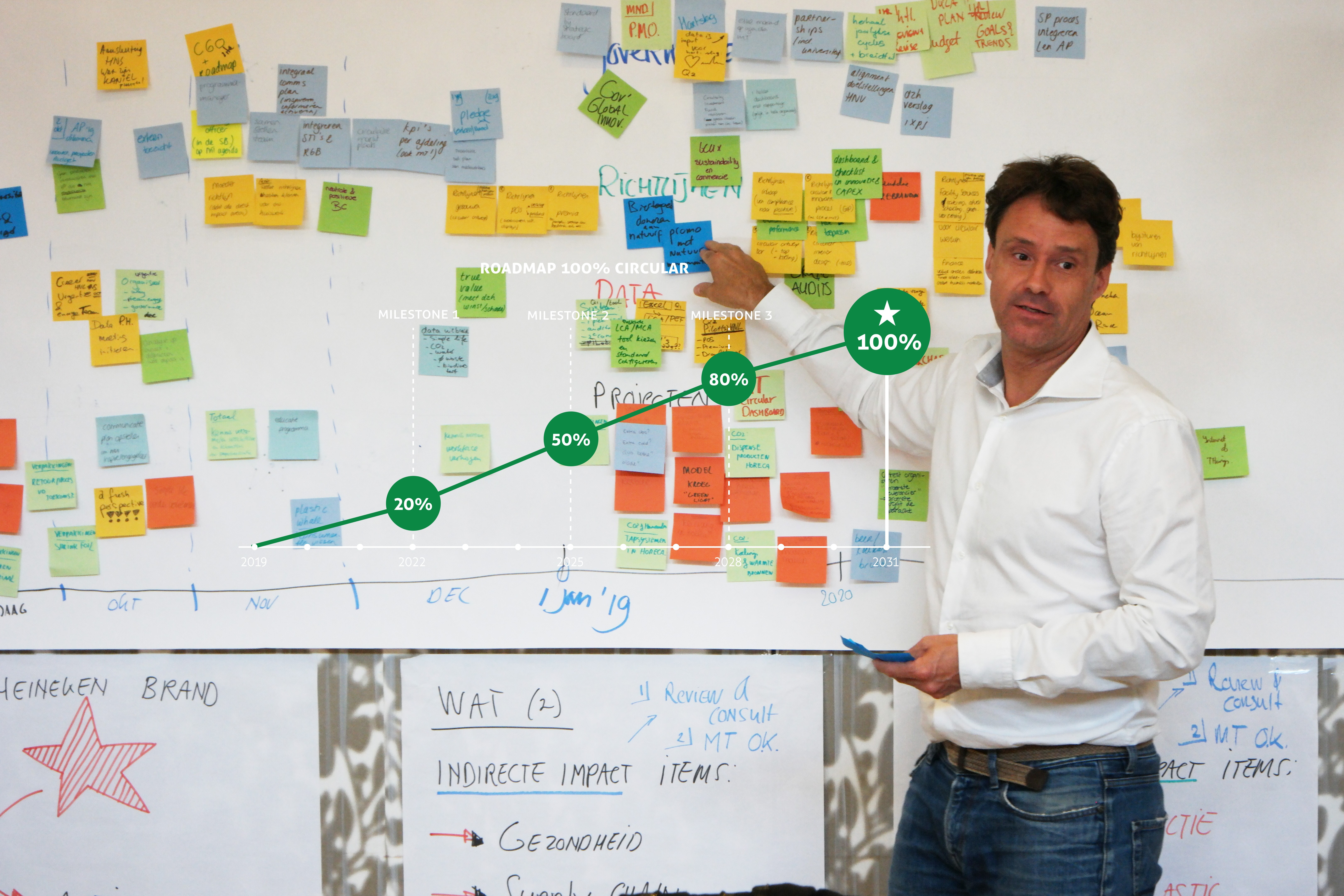
Free resources and SiD documentation
Before we go on, do you want to learn more about how to apply SiD, details on the steps above? For example, on how to assemble teams, gather intelligence, do systems analysis and perform cocreation to arrive at transformation roadmaps? There is a vast body of free and open source documentation available at www.thinksid.org.
Download the quickguide to get started with simple steps, or, for advanced work, read the 480 page in-depth SiD Omnibus reference document. Both are a free download.
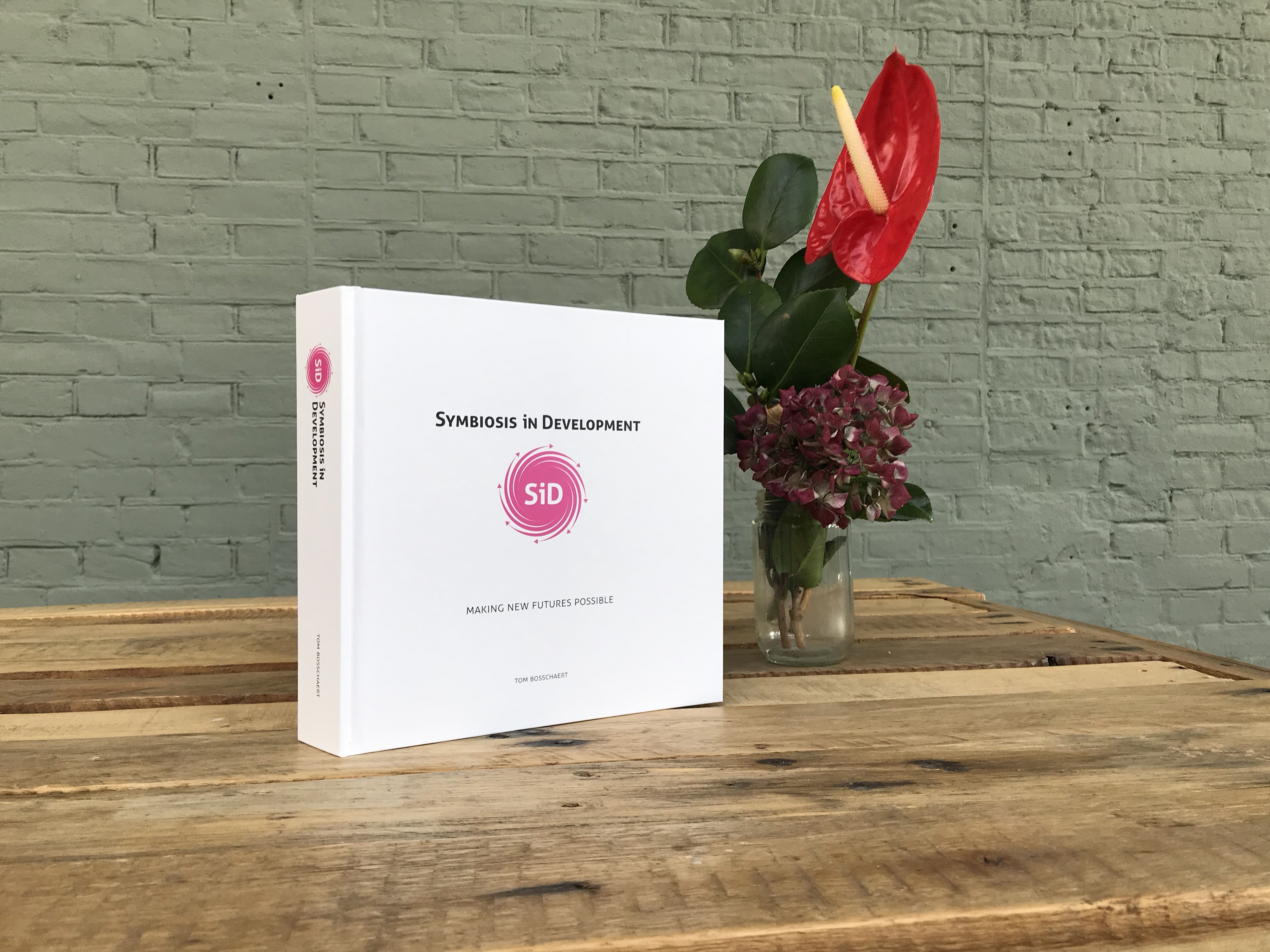
What do we need to realize regenerative cities?
We can build regenerative cities today. We have the tools, technology, and all of their components have been proven to work. That said, the widespread adoption of regenerative planning and development practice is far from today's reality. So what would greatly enhance and accelerate the development of these kinds of neighborhoods and cities? We list a few key points, in no particular order:
1. Awareness of Regenerative City potential and power
We can build them today, yes, and they have benefits both in the short term, for developers, investors, policy makers, businesses and community members. But does everyone know that, and is everyone convinced? Not at all. We need persistent, broad, and persuasive communication, development, and educational tools to increase the awareness and knowledge about these possibilities. So that those that are in the position to ask for regenerative practices, actually will.
2. Better tools, databases, and partnerships
Yes we can do it, but it takes a lot of effort. Effort that could be vastly eased with some smart tools and frameworks, supportive databases, and their partnerships. We are working with the Buckminster Fuller Institute to find funding to develop those tools, both for Orchid City and platforms that go beyond.
3. Increased funding
To do all this, we need funding. And the funding needed should increase across the board. In Asia, in Europe, in the US, in Africa, in the Middle East, everywhere. We're developing the frameworks, tools, and partnerships. Many organizations have valuable pieces of the puzzle. Bringing them together will unlock a vast opportunity, which is investible and can return in this investment. Finding the right investors, is the challenge. If you know a potential grant, fund, investor, or other funding agency, let us know, we can use the support.
Conclusion and Next Steps
Regenerative cities offer a powerful vision for urban environments that actively restore nature, enhance social well-being, and build resilient, flourishing economies. As shown in the year-long roadmap process, the journey toward regenerative urbanism begins with robust systems analysis, inclusive stakeholder co-creation, and iterative solution‑building—culminating in a living, long‑term plan that adapts to changing contexts and emerging insights.
Yet the roadmap does not mark the end of this journey; it provides the platform from which deeper transformations can unfold. Moving forward, cities can leverage robust frameworks like Symbiosis in Development (SiD) to align stakeholders around a shared vision, track progress, and integrate new ideas. SiD’s open‑source tools and materials are available at ThinkSiD.org, offering documentation, case studies, and technical support for those ready to take the next step.
Beyond SiD, many valuable resources and communities support regenerative development. Networks such as the Ellen MacArthur Foundation (focusing on circular economy) and research institutes like DRIFT (specialized in transition science) offer further guidance, best practices, and real‑world examples to learn from. By aligning these resources—systemic frameworks, collaborative platforms, and evidence‑based strategies—cities can lay the groundwork for not only surviving but thriving in the face of future challenges.
April 2, 2025
